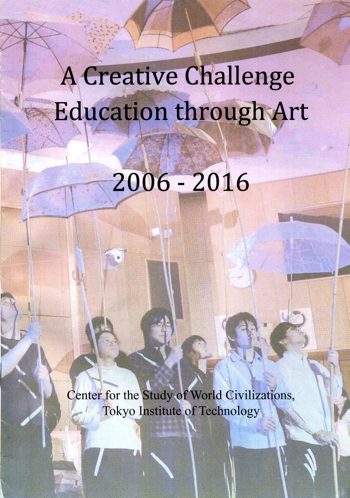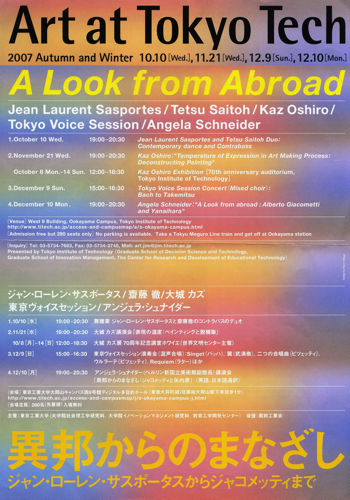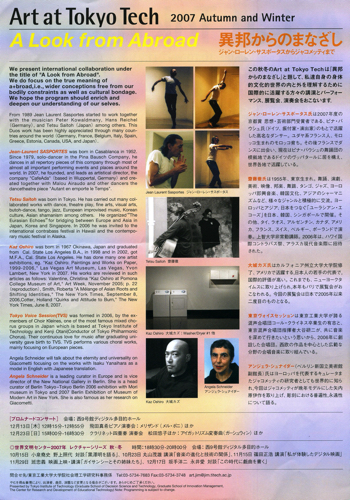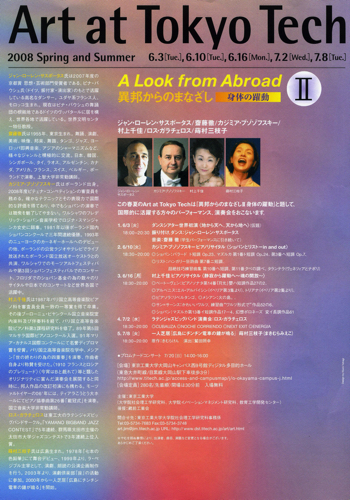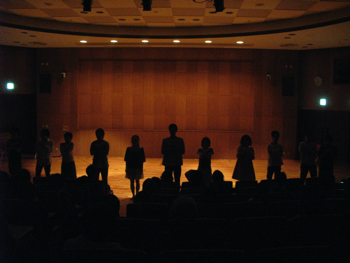- 🇬🇧english - pour le français, clic ici 🇫🇷
The CSWC, my work at the Center for Studies of the World Civilisations at the Tokyo Institut of Technology
- in English
This project has been initiated by Professor Noboru Hidano, Dr. Economics Program at Department of Social Engineering, Tokyo Tech, and by Professor Roger Pulvers who is now the actual Head of the Center.
in 2007, Professor Hidano did contact me and proposed me to have a thirty hours workshop session with some of his students with the goal to introduce them to the world of dance and dance-theatre, and propose a public presentation at the end of this Workshop. I will start this project in 2008, and worked on it till 2012.
I did study myself during a few years Mathematics, Physics and Chemistry, and even if I did not finished my study, because of my decision to become a dancer, I always kept a scientifical curiosity about those subjects, and the proposition of Professor Hidano mashed perfectly with my desire to find a way of understanding between my passion for body movement, dance and performing art and my old interest in this scientifical way of thinking.
My first question to Professor Hidano was:
- “why did you and your colleges created the Center of Study of World Civilisations ?, in which sense do you believe that “creating works of art and exploring the most basic and important aesthetic impulses that underpin culture” can be positive and necessary to University students in Science and Technology ?”.
Professor Hidano’s answer really impressed me:
- “There are two reasons I will tell you about, the first one is that, among our students, through the different workshops that we propose to them, a little percentage of them might discover a special interest in Art and could decide to use their scientifical knowledge to become artist instead of becoming engineers or searchers, we want to give to those students a possibility to discover their own impulses and realize themselves as well as possible. The second reason concern all the other students. Now a days. the battle to survive in our society seems to get always harder and harder, good engineers are well payed and the competition create a strong pressure and new motivation, different then the original motivation which should be the interest in Science and Technology. If this new motivation, created by the financial competition, becomes too important in regard to the original interest in what the students studied, the young professional engineers and searchers might loose the sense of why they are doing their profession. The students of our University have a strong and deep interest in what they are studying; It will be a big pity to see this strong and deep interest slowly disapear in their future and be replaced by the motivation created from the financial pressure; this matter of fact is a big danger for them and our society, when this kind of pressure takes too much importance in people’s motivation, it creates a hard and unhappy society. To discover the world of Art and Artistic Creativity is a way to developpe a human sensitivity to emotions and to the various faces of beauty; we believe that giving a possibility to our students to experiment and discover the world of Art and artistic creativity is to give them a good support to go through their life with a strong sense for humanity”.
A great way of thinking that could be applied also in our European universities…
My teaching field was « Dance and Stage Arts ». I have been working on thin project from 2008 till 2012.
Some of my students are still in contact with me and I had the pleasure to receive three of them in Wuppertal as they were doing their European visit after the ned of their studies.
IN 2011, Professor Roger Pulvers was director of the Center, but on his way to take his retreat in 2012. It is for this occasion that he ask me in 2011 to realise a choreographically piece with the students of the TokyoTech.
The subject of the piece should be about Kenji Miyazawa, a great Japanese poet and some poems out of his poetical work. Roger did the first english translation of Kenji´s work.
So this is how the dance-theatre piece « Looking for Kenji » has been created.
The first version of this piece was, in April 2011, with me and Tetsu Saitoh on stage, and some of the students of the CSWS.
2011 was the year when Japan, and specially the province of Iwate where Fukushima is, had to suffer from a tremendous earthquake, a devastating tsunami, and a nuclear catastrophe. Because of the uncertain situation, I had to delay my visit to Tokyo to one month later.
Kenji Miyazawa (1896-1933), is native of the province of Iwate which was a poor and unproductive land . He was an agriculture engineer and show a lot of concern for the agriculture workers, organising an association to teach them how to improve their working situation and productivity. All ready at his time, he expressed the danger of a non consideration of the natural needs due to a too strong modernisation of the agriculture rules. so making a piece about Kenji Miyazawa just one month after that his native homeland hase been shattered, was taking another meaning then in normal time.
This piece has the title of « Looking for Kenji », and the second version has been presented in April 2012 in Cafe Ada (Wuppertal) as memorial event of the 2011 disaster.
For more information about « Looking fo Kenji », please visit the following pages:
http://www.jsasportes.com/main/chore-kenji1.php
http://www.jsasportes.com/main/chore-kenji2.php
Publication writen by Jean Laurent Sasportes for the Tokyotech Chronicle:
 - a Dancetheatre Workshop for the CSWC - 2008 in PDF - a Dancetheatre Workshop for the CSWC - 2008 in PDF
 - a Dancetheatre Workshop for the CSWC - 2009 in PDF - a Dancetheatre Workshop for the CSWC - 2009 in PDF
en français 🇫🇷
Le CSWC, mon travail au Center for Studies of the World Civilisations at the Tokyo Institut of Technology
C’est en 2007 que, après un de mes cours á la Session House que Takashi me présente le Professeur Noboru Hidano.
Professeur Noboru Hidano était directeur du Programme économique au département
d’ingénierie sociale á l’Institut de Technologie de Tokyo.
Professeur Hidano cherchait á me contacter pour me proposer de présenter l’art de la danse-théâtre et mon propre travail aux étudiants du Tokyotech.
Ce projet était une initiative de Pr. Noboru et de Professeur Roger Pulvers, professeur d’anglais de Tokyotech et directeur du nouvel CWSC (Centre d’Études des Civilisations du Monde), Centre créé pour recevoir et développer ce projet.
Ma première réaction fut de demander á Pr. Noboru la raison pour laquelle lui et Pr. Pulvers avait créé ce projet. Sa réponse m’a beaucoup impressionné et je la garde toujours présente á mon esprit:
« Il y a deux raisons dont je vais vous parler. La première est que, parmi nos étudiants, un petit pourcentage d’entre eux pourrait découvrir un intérêt particulier dans l’art et de ce fait décider d’utiliser leur connaissance scientifique pour devenir des artistes plutôt que de devenir des ingénieurs ou des chercheurs scientifiques.
En ce qui concerne la deuxième raison, elle concerne tout les étudiants, et je vous dirais ceci:
« La vocation de notre université est de former des ingénieurs et scientifiques de haut niveaux qui vont par la suite travailler dans notre société.
De nos jours la lutte pour la survie dans notre société est de plus en plus dure. Les bons ingénieurs sont des personnes bien rémunérées et la compétition pour l’obtention de ces postes très convoités crée des pressions et peut amener á une nouvelle motivation différente de leur motivation initiale qui devrait être leur intérêt en la Science et la Technologie. Si cette nouvelle motivation créé par la compétition et l’attrait de l’argent prend trop d’importance en regard de leur intérêt initial, les jeunes ingénieurs et chercheurs que nous avon formé risque de perdre le lien avec ce qui les a amené á s’inscrire dans notre Institut.
Les étudiants de notre Université ont un grand et profond intérêt dans ce qu’ils étudient. Ce serait vraiment dommage de voir cet intérêt disparaître et être remplacé par des motivations pécuniaires. Ce genre de phénomène représente un danger pour notre société qui n’en devient que plus dure et impitoyable. Les gens n’en ressortent que plus malheureux.
Ces étudiants vont donc devenir des personnes á haute responsabilité et auront á prendre des décisions et faire des choix de grande importance.
Nous considérons que la sensibilisation aux arts et au langage artistique contribue très favorablement á développer la sensibilité humaine aux émotions et au divers facettes du « beau ». Nous espérons ainsi influencer leurs réflexions et leurs décisions dans leur futur professionnel vers un fort sens d’humanité. C’est dans ce but que nous avons créé ce Centre et c’est pourquoi nous vous proposons ce poste. »
Un projet et un point de vue qui j’espère pourrait peut-être inspirer nos Universités scientifiques européennes ..
Ma matière d’enseignement était « Danse et Arts de la scène ». Je travaillais á ce projet de 2008 jusqu’á 2011.
Certains de mes étudiants sont encore en contact avec moi et j’ai eu le plaisir de recevoir, á Wuppertal, trois d’entres eux qui, á l’occasion de la fin de leur études faisaient une visite de l’Europe.
En 2011, Professeur Roger Pulvers dirigeait le CSWC, mais il envisageait son départ en retraite pour l’année 2012. C’est pour cette occasion que, en 2011, il me proposa de réaliser une pièce chorégraphique avec les étudiants du TokyoTech.
Le sujet de cette pièce était le poète japonais Miyazawa Kenji et un de ses livres de poème dont Roger Pulvers avait fait la première traduction en langue anglaise.
C’est ainsi que fut créé la pièce « Looking for Kenji ».
Dans la première version créée en Avril 2011 avec la participation des étudiants de l’université, je dansais moi-même sur scène et mon ami, grand musicien et compositeur, Tetsu Saitoh jouait á mes cotés.
Le fait remarquable de ce projet était que 2011 fut l’année dans laquelle le Japon et son peuple a profondément souffert d’un tremblement de terre particulièrement fort, suivit d’un tsunami ravageur pour la province de Fukushima. Á cela s’est rajouté une catastrophe de centrale nucléaire dont les conséquences se font malheureusement encore sentir.
Á cause d’une situation très incertaine en ce qui concernait la radioactivité, j’avais du retarder ma visite de un mois.
Kenji Miyazawa (1896-1933), originaire de la région Iwate, est un poète et écrivain très connu au Japon. Il avait été ingénieur agronome et un des premiers á s’engager auprès des ouvriers agricole pour améliorer leurs conditions de travail, en créant par exemple une association réunissant des agriculteurs á qui il proposait des cours d’agronomie. Il avait déjà á son époque prévenu des dangers d’une modernisation trop poussée qui risquait de mener á des catastrophes incontrôlables.
La région de Iwate fut profondément touchée par la catastrophe de Fukushima, et présenter une pièce sur Kenji Miyazawa juste deux mois après cet évènement prenait une toute autre signification.
La pièce porte le titre « Looking for Kenji » et une deuxième version, cette fois-ci avec des danseurs professionnels et un violoniste (Naoki Kita) aux cotés de Tetsu sera travaillé en 2012 et présentée au Cafe Ada á Wuppertal.
Pour plus d’informations sur « Looking fo Kenji », merci de visiter les pages suivantes:
http://www.jsasportes.com/main/chore-kenji1.php
http://www.jsasportes.com/main/chore-kenji2.php
J’ai travaillé par session d’une trentaine d’heures chaque année en tant que professeur adjoint jusqu’en 2012 puis mon poste a été supprimé par manque de moyens financiers dû au restrictions budgétaires suite á la catastrophe de Fukushima.
Publication écrites par Jean Laurent Sasportes pour le " Tokyotech Chronicle":
 - a Dancetheatre Workshop for the CSWC - 2008 in PDF - a Dancetheatre Workshop for the CSWC - 2008 in PDF
 - a Dancetheatre Workshop for the CSWC - 2009 in PDF - a Dancetheatre Workshop for the CSWC - 2009 in PDF
|






